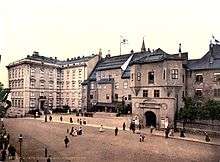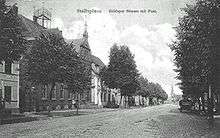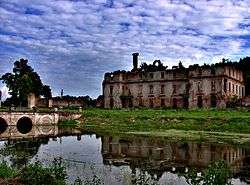Joachim Ludwig Schultheiss von Unfriedt
Joachim Ludwig Schultheiss von Unfriedt (variations include Schultheiß and Unfried, 1678 – 10 June 1753) was a German Baroque architect, official, and councillor most active in Königsberg and throughout East Prussia.
Life
Possibly born in Altruppin, Brandenburg, Schultheiss was the son of Joachim Scultetus von Unfried, a privy councilor of Frederick William I, Elector of Brandenburg.[1] He began studying at the University of Frankfurt (Oder) on 23 August 1689[1] and continued his studies in Italy and France. He became Royal Prussian Engineer and Building Master (Kgl. Preuß. Ingenieur und Baumeister) in Königsberg on 9 January 1702.[2] Schultheiss oversaw the transfer of material from the declining castle in Fischhausen to the fortifications of Pillau until 1705.[3] He was then named Building Director (Baudirektor) on 11 June 1705.[2]
From 1705-13 Schultheiss focused on renovating Königsberg Castle, especially an east wing which was alternately referred to as the Friedrichsbau, the Unfriedbau, and the Unfriedflügel.[4] From 1705-10 he worked on the galleries, royal lodge, and pulpit-altar of the Schlosskirche, the church connected to the castle. Schultheiss designed the Royal Orphanage in Sackheim (1703–05), Tragheim Church (1708–10), and the Brauerhaus in Löbenicht.[5] From 1704-05, along with Jean Baptiste Broebes and Johann Caspar Hindersin, he also aided in the transition of the manor house in Schlobitten into a palace of the Dohna family.[6] In 1708 he renovated the church of Kaukehmen.[7]
After the coronation of King Frederick William I of Prussia in 1713, Schultheiss took the position of building director in Berlin.[1] He returned to Königsberg after taking the position of building director for the Oberland district on 18 January 1721.[1] The king, who was focused on the recovery of East Prussia after the great plague of 1708-11, tasked Schultheiss with designing the new towns built in the province. He became the most important architectural official in East Prussia and a member of the Kriegs- und Domänenkammer after the king's reorganization of government in 1723.[2]
Schultheiss designed or altered the layouts of numerous East Prussian towns, including Stallupönen (1722);[8] Darkehmen and its 13 morgen market square (1723);[9] Ragnit's old town (1723);[10] Gumbinnen's old town (1724), new town (1727), and town hall (1727);[11] Schirwindt and its market square (ca. 1725);[12] and Pillkallen (ca. 1725).[13] Ca. 1730 he possibly worked on the family grave of Friedrich von der Groeben at the church of Groß Schwansfeld.[14] From 1731-32 he oversaw the rebuilding of the church in Drygallen.[15] Schultheiss designed the Neustädter Reformierte Kirche in Gumbinnen from 1736-39.[11]
In his second period in Königsberg, Schultheiss designed the incomplete Garnisonkirche (garrison church) of the Königsgarten (1731) and the French Reformed Church (1733–36) on Königstraße.[4] He died in Königsberg.
Gallery
-

East side of Königsberg Castle
-

French Reformed Church on Königstraße, eastern Königsberg
-

Tragheim Church in Tragheim, northern Königsberg
-

Royal Orphanage in Sackheim, eastern Königsberg
-

Goldaper Straße leading to the market in Stallupönen
-

Ruins of the Dohna Palace in modern Słobity, formerly Schlobitten
-

Market square of modern Ozyorsk, formerly Darkehmen
Notes
- 1 2 3 4 Mühlpfordt, Königsberger Skulptoren und ihre Meister 1255-1945 p. 162
- 1 2 3 Kreisgemeinschaft Gumbinnen
- ↑ Antoni, p. 175
- 1 2 Albinus, p. 282
- ↑ Mühlpfordt, Königsberg von A bis Z, p.133
- ↑ Weise, p. 204
- ↑ Antoni, p. 331
- ↑ Antoni, p. 155
- ↑ Weise, p. 36
- ↑ Antoni, p. 504
- 1 2 Antoni, p. 240
- ↑ Antoni, p. 559
- ↑ Antoni, p. 564
- ↑ Antoni, p. 232
- ↑ Antoni, p. 154
References
- Albinus, Robert (1985). Lexikon der Stadt Königsberg Pr. und Umgebung (in German). Leer: Verlag Gerhard Rautenberg. p. 371. ISBN 3-7921-0320-6.
- Antoni, Michael, ed. (1993). Dehio-Handbuch der Kunstdenkmäler: West- und Ostpreußen (in German). München: Deutscher Kunstverlag. p. 718. ISBN 3-422-03025-5.
- Kreisgemeinschaft Gumbinnen. "Personen" (in German). Retrieved 14 November 2010.
- Mühlpfordt, Herbert Meinhard (1972). Königsberg von A bis Z (in German). München: Aufstieg-Verlag. p. 168. ISBN 3-7612-0092-7.
- Mühlpfordt, Herbert Meinhard (1970). Königsberger Skulptoren und ihre Meister 1255-1945 (in German). Würzburg: Holzner Verlag. p. 299.
- Weise, Erich, ed. (1981). Handbuch der historischen Stätten Deutschlands, Ost- und Westpreussen (in German). Stuttgart: Alfred Kröner Verlag. p. 284. ISBN 3-520-31701-X.